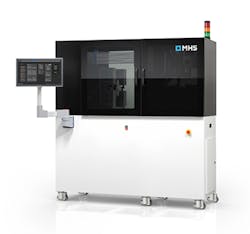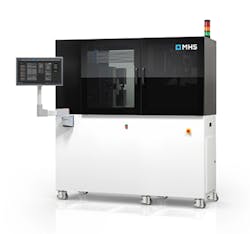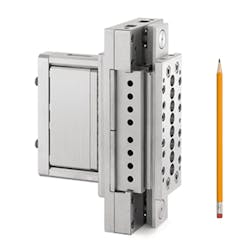The old adage says that bigger is better, but success for many manufacturers today lies in the ability to miniaturize: How can businesses pack more functionality into ever-smaller parts and components?
Fortunately, some equipment makers have been working on that very problem, and attendees at NPE2018 will see one of the newest and most innovative entries make its debut in Orlando: the M3-D08, the newest model in the M3 line of micro injection molding machines from MHS Mold Hotrunner Solutions.
The M3-D08 will replace the six-drop M3 mini, which was introduced in 2014. The new model features a bigger, eight-drop valve-gate hot-runner system and a host of upgrades and new features that make it ideal as a platform for molding small to micro-sized plastic parts.
Although the tie-bar-less machine can produce parts as large as 400 grams, the ability to produce miniscule parts is what sets it apart, making it valuable to makers of high-precision products such as medical devices and electronics.
"The fact that the parts can be produced via direct valve gate using our new proprietary injection technology — requiring no cold runners — is perhaps the most outstanding feature," said Jörg Schmidt, the company's director of business development. "It is also the key to unlocking many of the other unique processing benefits inside the molding cell."
The elimination of cold runners results in improved part quality, faster cycle times and less wasted material. That last one is a big help, especially since many of these extremely small parts are made from expensive materials such as PEEK and bioabsorbables.
Among the other advantages Schmidt cited are:
• The ability to produce parts as light as 0.001 gram with a gate diameter of 0.02 inch.
• High production outputs — up to 60 million direct-gated plastic parts annually.
• The ability to produce parts with different designs and weights in a single shot.
• The availability of integrated automation options, including touchless parts handling and takeout. The parts are ejected directly from the cavity into a micro chamber inside a vertical shuttle/robot and then transported down individual stainless steel tubes (one for each cavity) using filtered air or vacuum.
• User-friendly machine controls with a touch-screen interface and secure cloud access.
• Options that make the machine suitable for use in clean rooms.
• Lower operating costs, both from the reduction in material waste and the fact that the machine operates with a clamping force of only 4.5 tons, which is generated by industrial-grade electromagnets.
• A small footprint and the ability to easily move the press with leveling casters.
Many of the advantages that the company touts are based on its Isokor technology, which MHS describes as "a new rheological concept." By conditioning the polymer close to the gate, the machine reduces melt residence time and protects resin morphology. That's a critical factor because material degradation has always been one of the biggest hurdles for micro-injection molders to overcome.
"We don't use the term revolutionary loosely, but that's how we are describing the [ISOKOR] technology, in terms of what it does for the global micro-manufacturing industry," said Harald Schmidt, Jörg's father and president of MHS. "Plastic components made with the M3 will enable new designs for devices that simply were not possible before. Products made using conventional workarounds before can now be produced faster, better and more cost-effectively."
The M3's designers also chose to replace traditional injection molds with modular inserts, each of which contains eight cavities. That simplifies mold design and makes it easier to transition from prototyping to mass production because no validation is required — the parameters are identical for both.
From the beginning, Harald Schmidt said that development of the M3-D08 was all about meeting customer demands for miniaturization. "We believe that micro molding plays a critical role in the future of plastics production, and that now is the time for a big leap forward. Our goal is to take micro injection from a niche molding technology to the mainstream. The M3 makes it easy for OEMs and molders to get into the game.
"We want everyone to start thinking small. If it can be made with plastics — at this scale and speed, and direct-gated — there are so many advantages and possibilities," he said.
Michael T. McCue, copy editor
Contact:MHS Mold Hotrunner Solutions Inc. Georgetown, Ontario, 905-873-1954,


